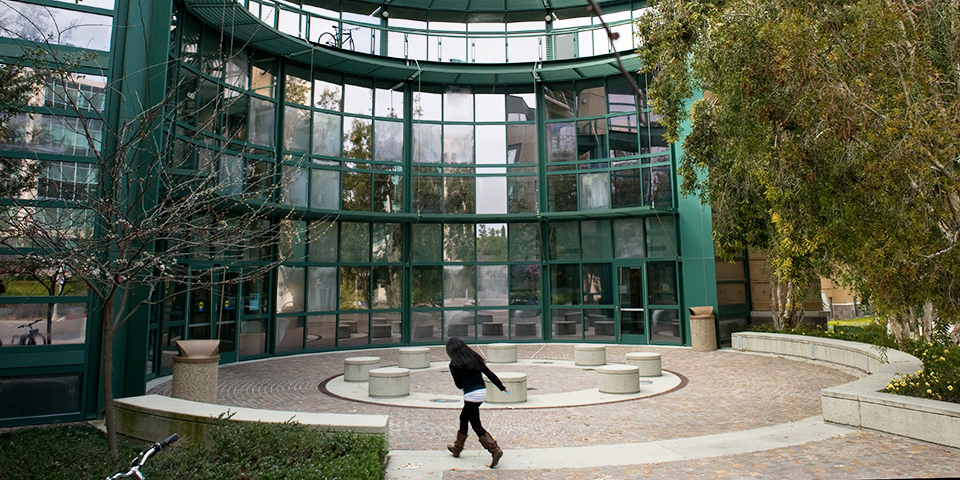School of Physical Sciences
About the school

Established in 1965 as one of the founding academic units at UCI, the School of Physical Sciences has built an international reputation of distinction in scientific research while also embracing the teaching mission of a public university. The school's world-renowned faculty members and research scientists teach and perform research alongside students to explore the ever-advancing frontiers of knowledge. From the first moments of the Big Bang to the future of Earth, from imaging individual atoms and molecules to modeling living cells and cancer tumors, and from synthesizing new molecules to the evolution of the universe, our scientists explore every corner of the universe to learn nature's secrets and to provide a foundation for creation of tools used by our modern technological society.
The school has four departments: Chemistry, Mathematics, Physics & Astronomy and Earth System Science — the first department of its kind in the nation. It enrolls 1,818 undergraduates and 536 graduate students. In 1995, the school garnered international prominence when founding faculty members F. Sherwood Rowland (Chemistry) and Frederick Reines (Physics & Astronomy) each received the Nobel Prize, making UCI the first public university with faculty receiving the award in two different fields in the same year.
Building on this foundation, 13 faculty members are members of the National Academy of Sciences and two are part of the National Academy of Engineering. Consistently, professors and students win prestigious awards recognizing their scientific excellence. Researchers are not only leading the world in addressing today's problems, they are simultaneously teaching the scientists who will be solving tomorrow's problems.
Along with traditional fields of inquiry, the school offers innovative graduate curricula, including programs in chemical & materials physics; mathematical biology; medicinal chemistry & pharmacology; polymer, materials & nanoscience; and atmospheric & environmental science.
Distinctions
- 13 School of Physical Sciences professors have been elected members of the National Academy of Sciences.
- More than 40 faculty members have been named Alfred P. Sloan Research Fellows.
- 3.88 is the average GPA of incoming undergraduate students.
- Approximately 1,818 undergraduate students and 536 graduate students are enrolled in the School of Physical Sciences. Doctoral degrees are granted from all four departments.
- 35% of the school's undergraduate students conduct research.
- The Department of Chemistry is one of the nation's largest producers of graduates with B.S. and Ph.D. degrees in chemistry.
- Earth system science is the first university department in the U.S. dedicated exclusively to understanding the scientific basis of global environmental problems.
- Earth system science professors regularly inform policy makers on environmental issues.
- U.S. News & World Report ranked the Chemistry Ph.D program 9th in the nation among public schools, and 20th overall. Organic chemistry was ranked 6th among public schools, and inorganic chemistry was ranked 7th.
- Physicists from the school played a key role in the discovery of the Higgs boson particle through their work on the Large Hadron Collider in Geneva, Switzerland.
- The Department of Mathematics hosts first-tier research programs in pure and applied mathematics, and is strongly committed to education and community outreach.
- The school offers state-of-the-art research facilities in molecular modeling, mass spectrometry, X-ray crystallography, nuclear magnetic resonance (NMR) spectroscopy.
Research Facilities
Research centers, units and institutes include:
- AirUCI
- Center for Chemical & Material Physics Program
- Center for Chemical & Structural Biology
- Center for Cosmology
- Center for Interdisciplinary Chemical Synthesis
- Center for Mathematical & Computational Biology
- Center for Solar Energy
- Chemistry at the Space-Time Limit (CaSTL)
- Eddleman Quantum Institute (EQI)
- Environment Institute
- Institute for Geophysics & Planetary Physics
- Institute for Surface & Interface Science
- Southern California Center for Galaxy Evolution
Specialized research facilities include:
- Array of Enhanced Nodes Supercomputer (AENEAS)
- Computational & Applied Mathematics Infrastructure
- Earth System Modeling
- Electronics Facility
- Instrumentation Development Facility
- Integrated Nanosystems Research
- Laser Spectroscopy, Molecular Modeling
- Nuclear Magnetic Resonance Spectroscopy
- Stable Isotope Ratio Mass Spectrometry
- W.M. Keck Carbon Cycle Mass Spectrometer
- X-Ray Crystallography
- UCI OCEANS Initiative
